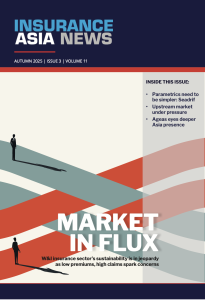P&C insurers in Asia have much higher equity risks than US peers: Moody’s
October 15 2024 by InsuranceAsia News-
APAC non-life insurers to remain stable in 2026 as capital strength offsets regulatory, catastrophe pressures: Fitch
- December 4
Stable margins and strong solvency expected, Fitch says, with disciplined pricing and steady reinsurance support underpinning a neutral outlook.
-
Australia’s Northern Territory counts the cost of Tropical Cyclone Fina
- November 24
Tropical Cyclone Fina passed near Darwin offshore on Saturday night, causing high winds and heavy rainfall and leaving thousands of residents in the region without power.
-
Sompo P&C’s adjusted profit rises 50% to US$1.5bn
- November 19
Improved performance mainly driven by lower nat cat costs and profit improvement in domestic P&C.
-
Hanwha on the hook as lead insurer for E-Land’s South Korea warehouse fire: reports
- November 17
Hyundai Marine & Fire Insurance, DB Insurance, KB Insurance, and Heungkuk Fire & Marine Insurance are other co-insurers of the building, with total policy limits of around US$261m.
-
QBE | Elevating customer experience, humanising claims: QBE Asia’s ‘Solutions in a Box’
Vastly improving turnaround times and personalising service delivery, QBE Asia’s award-winning, end-to-end bundled claims solutions is a game-changer for the insurance industry.
-
Beazley | What does cyber protection look like from day 1 to day 600 and beyond?
Cybersecurity is no longer just an IT concern, but a governance issue that belongs on the boardroom agenda.
-
Sedgwick | Preparing for the next storm
Insurance industry needs to recalibrate, invest in innovation and strengthen systems, talent and data practices.
-
Peak Re | From climate modelling to market opportunity: Forging a new clarity on Southeast Asia’s climate risk
Southeast Asia's protection gap: a crisis of clarity, not just capital


